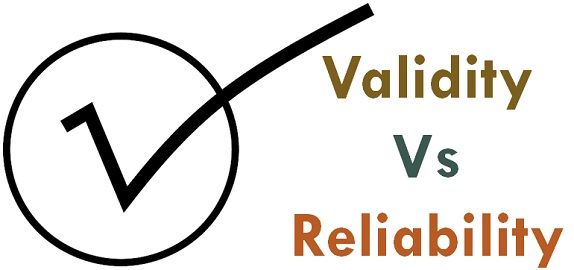 Simply, the validity of the measuring instrument represents the degree to which the scale measures what it is expected to measure. It is not same as reliability, which refers to the degree to which measurement produces consistent outcomes.
Simply, the validity of the measuring instrument represents the degree to which the scale measures what it is expected to measure. It is not same as reliability, which refers to the degree to which measurement produces consistent outcomes.
For the purpose of checking the accuracy and applicability, a multi-item measurement scale needs to be evaluated, in terms of reliability, validity, and generalizability. These are certain preferred qualities which gauge the goodness in measuring the characteristics under consideration. Validity is all about the genuineness of the research, whereas reliability is nothing but the repeatability of the outcomes. This article will break down the fundamental differences between validity and reliability.
Content: Validity Vs Reliability
Comparison Chart
| Basis for Comparison | Validity | Reliability |
|---|---|---|
| Meaning | Validity implies the extent to which the research instrument measures, what it is intended to measure. | Reliability refers to the degree to which scale produces consistent results, when repeated measurements are made. |
| Instrument | A valid instrument is always reliable. | A reliable instrument need not be a valid instrument. |
| Related to | Accuracy | Precision |
| Value | More | Comparatively less. |
| Assessment | Difficult | Easy |
Definition of Validity
In statistics, the term validity implies utility. It is the most important yardstick that signals the degree to which research instrument gauges, what it is supposed to measure.
Simply, it measures the point to which differences discovered with the scale reflect true differences, among objects on the characteristics under study, instead of a systematic and random error. To be considered as perfectly valid, it should not possess any measurement error. There are three types of validity, which are:
- Content Validity: Otherwise known as face validity, it is the point to which the scale provides adequate coverage of the subject being tested.
- Criterion Validity: The type of validity which gauges the performance of measuring instrument, i.e. whether it performs as expected or estimated, with respect to the other variables, chosen as a meaningful parameter. The criterion should be relevant, unbiased, reliable, etc.
- Construct Validity: Construct validity in a measure refers to the extent to which it adheres to estimated correlations with other theoretical suppositions. It includes:
- Convergent Validity
- Discriminant Validity
- Nomological Validity
Definition of Reliability
Reliability is used to mean the extent to which the measurement tool provides consistent outcomes if the measurement is repeatedly performed. To assess reliability approaches used are test-retest, internal consistency methods, and alternative forms. There are two key aspects, which requires being indicated separately are:
- Stability: Degree of stability can be checked by making a comparison of the results of repeated measurement.
- Equivalence: Equivalence can be gauged when two researchers compare the observations of the same events.
Systematic errors do not affect reliability, but random errors lead to inconsistency of the results, thus lower reliability. When the research instrument conforms to reliability, then one can be sure that the temporary and situational factors are not interfering. Reliability can be improved by way of:
- Standardizing the conditions under which the measurement occurs, i.e. source through which variation takes place should be removed or minimized.
- Designing the directions carefully for measurement by employing such individuals who have got enough experience and are motivated too, for carrying out research and also by increasing the number of samples being tested.
Key Differences Between Validity and Reliability
The points presented below, explains the fundamental differences between validity and reliability:
- The degree to which the scale gauges, what it is designed to gauge, is known as validity. On the other hand, reliability refers to the degree of reproducibility of the results, if repeated measurements are done.
- When it comes to the instrument, a valid instrument is always reliable, but the reverse is not true, i.e. a reliable instrument need not be a valid instrument.
- While evaluating multi-item scale, validity is considered more valuable in comparison to reliability.
- One can easily assess the reliability of the measuring instrument, however, to assess validity is difficult.
- Validity focuses on accuracy, i.e. it checks whether the scale produces expected results or not. Conversely, reliability concentrates on precision, which measures the extent to which scale produces consistent outcomes.
Conclusion
To sum up, validity and reliability are two vital test of sound measurement. Reliability of the instrument can be evaluated by identifying the proportion of systematic variation in the instrument. On the other hand, the validity of the instrument is assessed by determining the degree to which variation in observed scale score indicates actual variation among those being tested.






Mary says
Quite informative and user-friendly. It is written in simple language to understand.
Bravo!
Md. Zahirul Islam says
Thanks for details. #Respect
Quickbooks Enterprise Support says
that was really greatly explained. thanks for sharing this.
Pierrette Nyiramahirwe says
provides good and valid information! thank you so much 👏
Dipak RaI says
Thanks a lot for your clear explanation. I am overwhelmed.
Avi Deshmukh says
Indeed, good clarity on two interrelated components of statistical and research tools.
Kipsang Gideon says
good information on research details and detailed information on matters of research.